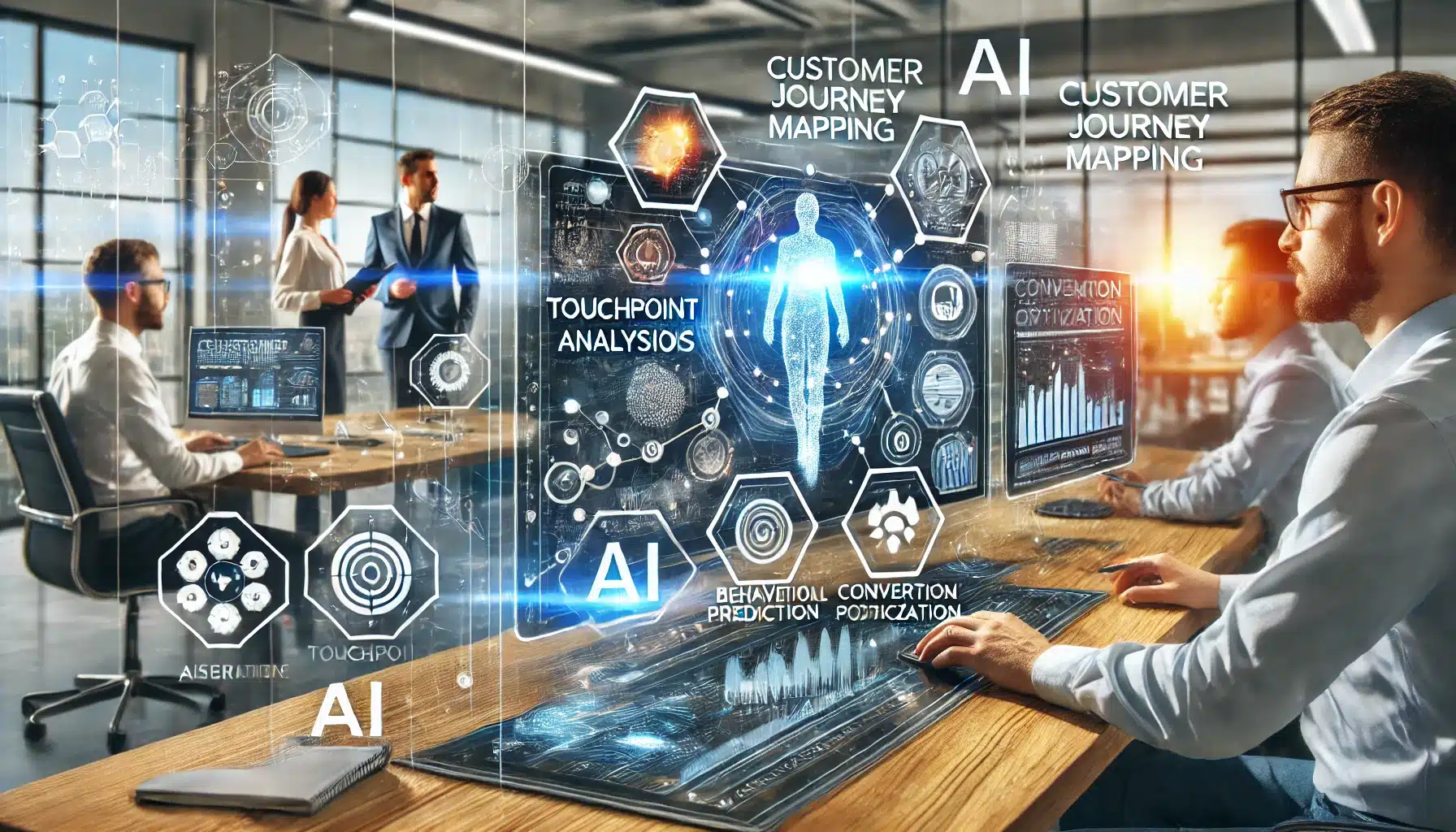Introduction
In today’s competitive business landscape, understanding and optimizing the customer journey is crucial for delivering exceptional user experiences. Traditional methods of mapping customer journeys often fall short in capturing the complexity and dynamism of modern consumer behavior. This is where AI-enhanced customer journey mapping comes into play. By leveraging advanced AI tools, businesses can gain deeper insights into customer interactions, predict behaviors, and optimize conversion rates. This article explores the transformative role of AI in customer journey mapping, its benefits, and best practices for implementation.
The Concept of Customer Journey Mapping
What is Customer Journey Mapping?
Customer journey mapping is the process of visualizing the steps a customer takes to interact with a brand, from initial awareness to post-purchase support. It identifies key touchpoints and highlights areas where improvements can enhance the overall experience.
Touchpoint Analysis
Touchpoints are the various interactions a customer has with a brand across different channels. Analyzing these touchpoints helps businesses understand the customer’s path and identify pain points or opportunities for engagement.
The Limitations of Traditional Customer Journey Mapping
Traditional customer journey mapping methods rely heavily on qualitative data and manual processes. These approaches can be time-consuming, lack real-time insights, and often fail to capture the full scope of customer interactions.
The Role of AI in Customer Journey Mapping
AI-Powered Touchpoint Analysis
AI algorithms can analyze vast amounts of data from multiple touchpoints, providing a comprehensive view of the customer journey. By examining interactions across various channels, AI helps businesses identify trends, patterns, and pain points more accurately.
Real-Time Data Collection
AI tools collect and analyze data in real-time, offering up-to-date insights into customer behavior. This real-time analysis enables businesses to respond promptly to changes in customer preferences or market conditions.
Sentiment Analysis
AI-powered sentiment analysis tools can gauge customer emotions based on their interactions. By understanding customer sentiments, businesses can tailor their strategies to enhance satisfaction and loyalty.
Behavioral Predictions
AI leverages machine learning to predict customer behavior based on historical data. These predictions help businesses anticipate customer needs and tailor their marketing efforts accordingly.
Predictive Analytics
Predictive analytics use historical data to forecast future trends. In customer journey mapping, AI utilizes predictive analytics to anticipate which actions a customer is likely to take next, enabling proactive engagement.
Personalized Recommendations
AI-driven recommendation engines analyze customer behavior to provide personalized suggestions. These recommendations enhance the customer experience by offering relevant products or services, increasing the likelihood of conversion.
Conversion Optimization
AI optimizes the customer journey by identifying factors that influence conversion rates. By analyzing customer behavior and engagement metrics, AI tools can suggest improvements to enhance the likelihood of conversion.
A/B Testing
AI-powered A/B testing tools can run multiple variations of marketing campaigns simultaneously, analyzing performance to determine the most effective approach. This ensures that marketing efforts are continuously optimized for better results.
Funnel Analysis
Funnel analysis involves examining the steps customers take to complete a desired action, such as making a purchase. AI tools can identify drop-off points in the funnel and suggest strategies to retain customers and increase conversions.
Benefits of AI-Enhanced Customer Journey Mapping
Comprehensive Insights
AI provides a holistic view of the customer journey by analyzing data from multiple touchpoints. This comprehensive insight enables businesses to understand customer behavior more deeply and make informed decisions.
Enhanced Personalization
AI tailors the customer experience by providing personalized recommendations and content. This level of personalization increases customer satisfaction and loyalty, driving higher engagement and conversion rates.
Increased Efficiency
AI automates various aspects of customer journey mapping, reducing the need for manual intervention. This increases efficiency, allowing businesses to focus on strategic activities and innovation.
Real-Time Adaptation
AI’s ability to analyze data in real-time enables businesses to adapt their strategies promptly. This agility ensures that businesses can respond to changing customer needs and market conditions effectively.
Implementing AI in Customer Journey Mapping
Choosing the Right AI Tools
Several AI-powered platforms can assist businesses in customer journey mapping. Tools like Adobe Experience Cloud, Salesforce Einstein, and HubSpot offer comprehensive features for touchpoint analysis, behavioral predictions, and conversion optimization.
Integrating AI with Human Expertise
While AI can handle many tasks, human expertise is still crucial. Marketing teams should work alongside AI tools to interpret data, make strategic decisions, and maintain personal relationships with customers.
Best Practices for AI-Enhanced Customer Journey Mapping
Define Clear Objectives
Before leveraging AI, businesses should define their customer journey mapping objectives. Whether it’s improving customer satisfaction, increasing conversion rates, or enhancing personalization, clear goals will guide the AI’s analysis and recommendations.
Regularly Update Data
Ensure that AI tools are fed with the latest data. Customer behaviors and market conditions can change rapidly, and keeping the data current is essential for accurate predictions and insights.
Monitor and Adjust Strategies
Use AI to monitor customer journey performance and make real-time adjustments. AI can provide insights into what’s working and what’s not, allowing for quick pivots and optimizations.
Collaborating with AI
Successful customer journey mapping requires collaboration and communication. Here’s how AI can facilitate this process:
Streamlined Workflow
AI tools often include features for streamlined workflow management, allowing businesses to manage all aspects of customer journey mapping from a single platform. This makes it easier to coordinate tasks and ensure consistent quality.
Performance Tracking
AI can track the performance of customer journey strategies in real-time, providing businesses with detailed analytics on engagement, conversion rates, and ROI. This data is crucial for assessing the effectiveness of strategies and making informed decisions.
Content Personalization
AI can analyze customer data to personalize content and engagement strategies. This ensures that each interaction resonates with the target audience, enhancing engagement and driving better results.
Case Studies: Success Stories of AI-Enhanced Customer Journey Mapping
Case Study 1: Brand A
Brand A, a leading e-commerce retailer, used AI-powered customer journey mapping to enhance user experience. By leveraging AI for touchpoint analysis and behavioral predictions, Brand A significantly improved customer satisfaction and increased conversion rates.
The Challenge
Brand A needed to understand and optimize the complex customer journeys on their platform. Traditional methods were not yielding the desired insights.
The Solution
Using an AI-powered customer journey mapping tool, Brand A analyzed customer interactions across various touchpoints. The AI provided real-time insights and personalized recommendations.
The Results
The campaign led to a significant increase in customer satisfaction and conversion rates. AI-enhanced customer journey mapping allowed Brand A to create a seamless and engaging user experience.
Case Study 2: Brand B
Brand B, a global travel agency, utilized AI to optimize their customer journey mapping efforts. AI helped them achieve a 50% increase in conversions and a 30% reduction in customer churn.
The Challenge
Brand B faced the challenge of understanding the diverse journeys of their global customer base. Traditional methods of journey mapping were not effective in capturing the full scope of interactions.
The Solution
AI tools helped Brand B analyze customer data and predict travel preferences. The AI optimized engagement strategies and provided personalized recommendations to enhance the customer experience.
The Results
The campaign resulted in a significant increase in conversions and a reduction in customer churn. AI-powered customer journey mapping enabled Brand B to effectively engage their audience and achieve their business objectives.
The Future of AI in Customer Journey Mapping
Enhanced Predictive Capabilities
As AI continues to evolve, predictive analytics will play a more significant role in customer journey mapping. AI tools will not only track current behaviors but also predict future trends, helping businesses stay ahead of potential issues.
Advantages of Predictive Analytics
Predictive analytics provide businesses with foresight, allowing them to anticipate and prepare for potential challenges. This proactive approach enhances customer engagement and satisfaction.
Potential Challenges
While predictive analytics offer many advantages, they also come with challenges. Ensuring the accuracy of predictions and interpreting complex data require advanced skills and expertise.
Increased Personalization
AI’s ability to analyze vast amounts of data will lead to more personalized customer journey strategies. Businesses will be able to create highly targeted content that resonates deeply with specific audience segments.
Hyper-Targeted Campaigns
AI can segment audiences with incredible precision, allowing businesses to tailor their messaging to individual preferences and behaviors. This level of personalization enhances engagement and effectiveness.
Real-Time Adaptation
AI can adapt customer journey strategies in real-time based on audience responses. If certain content is performing well, AI can adjust the strategy to amplify successful elements and mitigate underperforming aspects.
Ethical Considerations
With great power comes great responsibility. The use of AI in customer journey mapping raises ethical questions around data privacy and transparency. Businesses must ensure they use AI responsibly and maintain consumer trust.
Data Privacy
Businesses must be transparent about how they collect and use data. Ensuring compliance with regulations like GDPR is essential to maintain consumer trust and avoid legal repercussions.
Transparency
Transparency in AI-driven customer journey mapping is crucial. Businesses should clearly communicate how AI is used in their journey mapping strategies and ensure that customer relationships are authentic and transparent.
Q&A Section
Q1: What is customer journey mapping?
A1: Customer journey mapping is the process of visualizing the steps a customer takes to interact with a brand, from initial awareness to post-purchase support. It identifies key touchpoints and highlights areas for improvement to enhance the overall experience.
Q2: How does AI enhance touchpoint analysis in customer journey mapping?
A2: AI enhances touchpoint analysis by analyzing vast amounts of data from multiple touchpoints, providing a comprehensive view of the customer journey. It identifies trends, patterns, and pain points more accurately and in real-time.
Q3: What role does AI play in behavioral predictions?
A3: AI uses machine learning to predict customer behavior based on historical data. These predictions help businesses anticipate customer needs, tailor marketing efforts, and provide personalized recommendations.
Q4: How does AI optimize conversion rates?
A4: AI optimizes conversion rates by analyzing customer behavior and engagement metrics. It identifies factors influencing conversions and suggests improvements, such as A/B testing and funnel analysis, to enhance the likelihood of conversions.
Q5: What are the benefits of using AI in customer journey mapping?
A5: Benefits include comprehensive insights, enhanced personalization, increased efficiency, and real-time adaptation. AI provides a holistic view of the customer journey, personalizes experiences, automates tasks, and enables prompt responses to changing customer needs.
Q6: How can businesses implement AI in customer journey mapping?
A6: Businesses can implement AI by choosing the right AI tools, integrating AI with human expertise, defining clear objectives, regularly updating data, and monitoring and adjusting strategies. Tools like Adobe Experience Cloud and Salesforce Einstein offer comprehensive features for this purpose.
Q7: What are the ethical considerations when using AI in customer journey mapping?
A7: Ethical considerations include data privacy and transparency. Businesses must be transparent about data collection and usage, comply with regulations like GDPR, and maintain authentic relationships with customers to build trust.
Conclusion
AI-enhanced customer journey mapping is transforming how businesses engage with their customers. By leveraging advanced AI tools for touchpoint analysis, behavioral predictions, and conversion optimization, businesses can gain deeper insights into customer interactions, predict behaviors, and optimize conversion rates. The benefits include comprehensive insights, enhanced personalization, increased efficiency, and real-time adaptation. As AI continues to evolve, it promises a future where customer journey mapping becomes even more predictive, personalized, and ethically sound, ensuring businesses can navigate the digital landscape with greater confidence and success.


